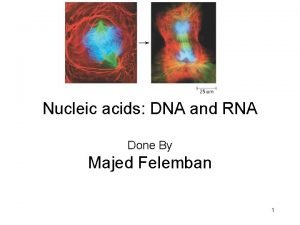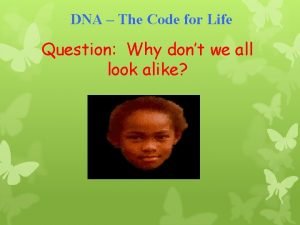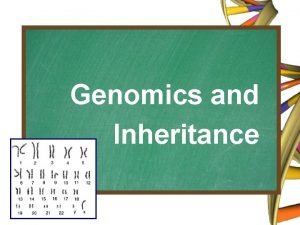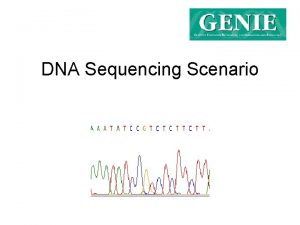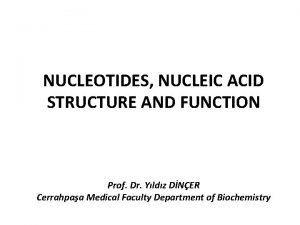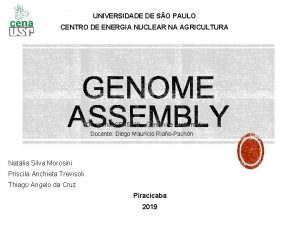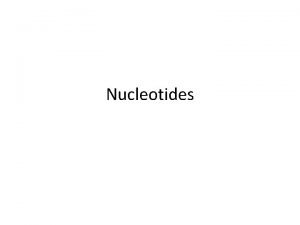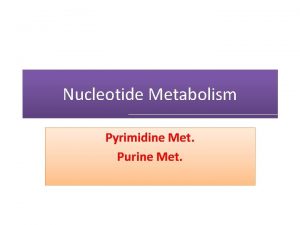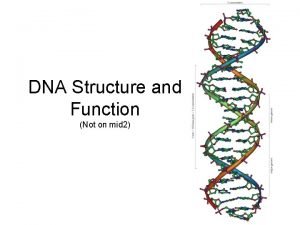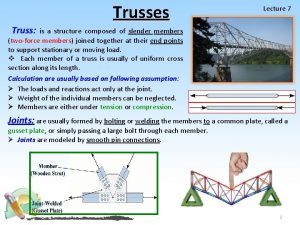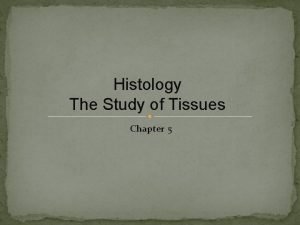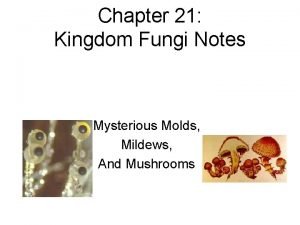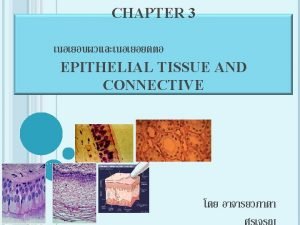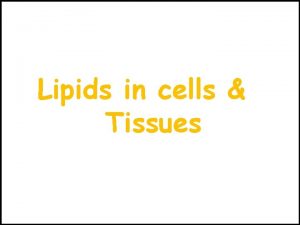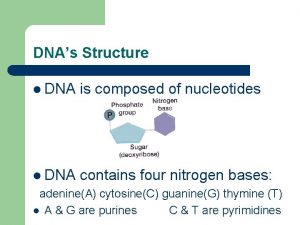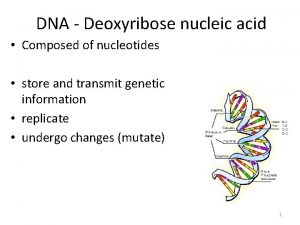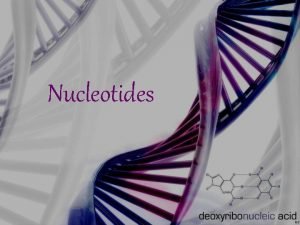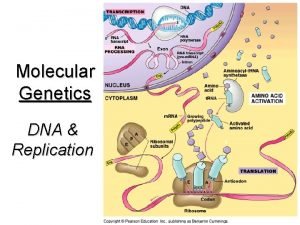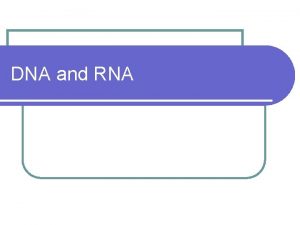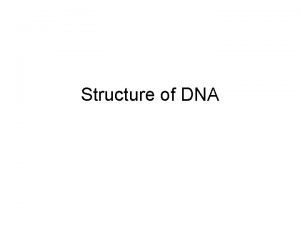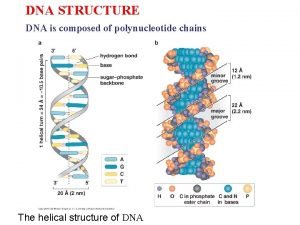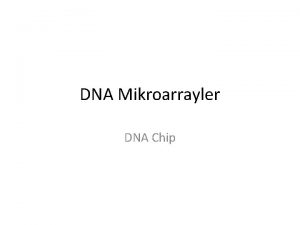DNA is composed of four nucleotides DNA is







































- Slides: 39

DNA is composed of four nucleotides DNA is made of chains of small subunits called nucleotides Each nucleotide has three components 1. A phosphate group 2. A deoxyribose sugar 3. One of four nitrogen-containing bases 1. Thymine (T) 2. Cytosine (C) 3. Adenine (A) 4. Guanine (G) © 2014 Pearson Education, Inc.

© 2014 Pearson Education, Inc.

nucleotide Phosphate-yellow Sugar-blue Base-A, C, T, G © 2014 Pearson Education, Inc.

DNA is a double helix of two nucleotide strands (continued) James Watson and Francis Crick combined the X-ray data with bonding theory to deduce the structure of DNA They proposed that a single strand of DNA is a polymer consisting of many nucleotide subunits Within each DNA strand, the phosphate group of one nucleotide bonds to the sugar of the next nucleotide in the same strand The deoxyribose and phosphate portions make up the sugar-phosphate backbone © 2014 Pearson Education, Inc.

Hydrogen bonds between complementary bases hold two DNA strands together in a double helix (continued) Because of their structures and the way they face each other, adenine (A) bonds only with thymine (T) and guanine (G) bonds only with cytosine (C) Bases that bond with each other are called complementary base pairs Thus, if one strand has the base sequence CGTTTAGCCC, the other strand must have the sequence GCAAATCGGG © 2014 Pearson Education, Inc.

Parental DNA double helix The parental DNA is unwound New DNA strands are synthesized with bases complementary to the parental strands Each new double helix is composed of one parental strand (blue) and one new strand (red) © 2014 Pearson Education, Inc.

10. 1 What Is the Physical Basis of Inheritance? § Inheritance is the process by which the traits of organisms are passed to their offspring © 2014 Pearson Education, Inc.

10. 1 What Is the Physical Basis of Inheritance? § Genes are sequences of nucleotides at specific locations on chromosomes – Inheritance is the process by which the characteristics of individuals are passed to their offspring – A gene is a unit of heredity that encodes information needed to produce proteins, cells, and entire organisms – Genes comprise segments of DNA ranging from a few hundred to many thousands of nucleotides in length – The location of a gene on a chromosome is called its locus (plural, loci) © 2014 Pearson Education, Inc.

10. 1 What Is the Physical Basis of Inheritance? § Genes are sequences of nucleotides at specific locations on chromosomes (continued) – Homologous chromosomes carry the same kinds of genes for the same characteristics – Genes for the same characteristic are found at the same loci on both homologous chromosomes – Genes for a characteristic found on homologous chromosomes may not be identical – Alternative versions of genes found at the same gene locus are called alleles © 2014 Pearson Education, Inc.

10. 1 What Is the Physical Basis of Inheritance? § Mutations are the source of alleles – Alleles arise as mutations—changes in the nucleotide sequence in genes – If a mutation occurs in a cell that becomes a sperm or egg, it can be passed on from parent to offspring – Most mutations occurring in the DNA of an organism initially appeared in the reproductive cells – New mutations may have occurred in reproductive cells of the organism’s own parents, but this is quite a rarity © 2014 Pearson Education, Inc.

10. 1 What Is the Physical Basis of Inheritance? § An organism’s two alleles may be the same or different – Each cell carries two alleles per characteristic, one on each of the two homologous chromosomes – If both homologous chromosomes carry the same allele (gene form) at a given gene locus, the organism is homozygous at that locus – If two homologous chromosomes carry different alleles at a given locus, the organism is heterozygous at that locus (a hybrid) © 2014 Pearson Education, Inc.

Figure 10 -1 The relationships among genes, alleles, and chromosomes a pair of homologous chromosomes Both chromosomes carry the same allele of the gene at this locus; the organism is homozygous at this locus gene loci This locus contains another gene for which the organism is homozygous Each chromosome carries a different allele of this gene, so the organism is heterozygous at this locus the chromosome from the male parent © 2014 Pearson Education, Inc. the chromosome from the female parent

10. 2 How Were the Principles of Inheritance Discovered? § Gregor Mendel, an Austrian monk, discovered the common patterns of inheritance and many essential facts about genes, alleles, and the distribution of alleles in gametes and zygotes during sexual reproduction § He chose the edible pea plant for his experiments, which took place in the monastery garden § Mendel’s background allowed him to see patterns in the way plant characteristics were inherited © 2014 Pearson Education, Inc.

Figure 10 -2 Gregor Mendel © 2014 Pearson Education, Inc.

10. 2 How Were the Principles of Inheritance Discovered? – Pea plants have qualities that make them a good organism for studying inheritance – Pea flowers have stamens, the male structures that produce pollen, which in turn contain the sperm (male gametes); sperm are gametes and pollen is the vehicle – Pea flowers have carpels, female structures housing the ovaries, which produce the eggs (female gametes) – Pea flower petals enclose both male and female flower parts and prevent entry of pollen from another pea plant © 2014 Pearson Education, Inc.

Figure 10 -3 Flowers of the edible pea intact pea flower dissected to show its reproductive structures Carpel (female, produces eggs) Stamens (male, produce pollen grains that contain sperm) © 2014 Pearson Education, Inc.

10. 2 How Were the Principles of Inheritance Discovered? § Doing it right: The secrets of Mendel’s success (continued) – Because of their structure, pea flowers naturally selffertilize – Pollen from the stamen of a plant transfers to the carpel of the same plant, where the sperm then fertilizes the plant’s eggs © 2014 Pearson Education, Inc.

10. 2 How Were the Principles of Inheritance Discovered? § Doing it right: The secrets of Mendel’s success (continued) – Mendel was able to mate two different plants by hand (cross-fertilization) – Female parts (carpels) were dusted with pollen from other selected plants © 2014 Pearson Education, Inc.

10. 2 How Were the Principles of Inheritance Discovered? § Doing it right: The secrets of Mendel’s success (continued) – Unlike previous researchers, Mendel chose a simple experimental design – He chose to study individual characteristics (called traits) that had unmistakably different forms, such as white versus purple flowers – He started out by studying only one trait at a time © 2014 Pearson Education, Inc.

10. 2 How Were the Principles of Inheritance Discovered? § Doing it right: The secrets of Mendel’s success (continued) – Mendel employed numerical analysis in studying the traits – He followed the inheritance of these traits for several generations, counting the numbers of offspring with each type of trait – By analyzing these numbers, he saw the basic patterns of inheritance emerge © 2014 Pearson Education, Inc.

10. 3 How Are Single Traits Inherited? § True-breeding organisms possess traits that remain inherited unchanged by all offspring produced by selffertilization § Mendel’s cross-fertilization of pea plants used true-breeding organisms § Mendel cross-fertilized true-breeding, white-flowered plants with true-breeding, purple-flowered plants – The parents used in a cross are part of the parental generation (known as P) – The offspring of the P generation are members of the first filial generation (F 1) – Offspring of the F 1 generation are members of the F 2 generation © 2014 Pearson Education, Inc.

Figure 10 -4 Cross of pea plants true-breeding for white or purple flowers pollen Parental generation (P) pollen cross-fertilize true-breeding, purple-flowered plant true-breeding, white-flowered plant First-generation offspring (F 1) all purple-flowered plant © 2014 Pearson Education, Inc.

10. 3 How Are Single Traits Inherited? § Mendel’s flower color experiments – Mendel allowed the F 1 generation to self-fertilize – The F 2 was composed of 3/4 purple-flowered plants and 1/4 white-flowered plants, a ratio of 3: 1 – The results showed that the white trait had not disappeared in the F 1 but merely was hidden – Mendel then self-fertilized the F 2 generation – In the F 3 generation, all the white-flowered F 2 plants produced white-flowered offspring – These proved to be true-breeding © 2014 Pearson Education, Inc.

10. 3 How Are Single Traits Inherited? § In the F 3 generation, self-fertilized purple-flowered F 2 plants produced two types of offspring – About 1/3 were true-breeding for purple – The other 2/3 were hybrids that produced both purple - and white-flowered offspring, again, in the ratio of 3 purple to 1 white – Therefore, the F 2 generation included 1/4 truebreeding purple-flowered plants, 1/2 hybrid purple, and 1/4 true-breeding white-flowered plants © 2014 Pearson Education, Inc.

Figure 10 -5 Self-fertilization of F 1 pea plants with purple flowers Firstgeneration offspring (F 1) self-fertilize Secondgeneration offspring (F 2) 3/4 purple © 2014 Pearson Education, Inc. 1/4 white

Figure 10 -6 The distribution of alleles in gametes homozygous parent A A gametes A A Gametes produced by a homozygous parent heterozygous parent A a gametes A a Gametes produced by a heterozygous parent © 2014 Pearson Education, Inc.

10. 3 How Are Single Traits Inherited? § The inheritance of dominant and recessive alleles on homologous chromosomes can explain the results of Mendel’s crosses (continued) – There are two alleles for a given gene characteristic (such as flower color) – Let P stand for the dominant purple-flowered allele: A homozygous purple-colored plant has two alleles for purple flower color (PP) and produces only P gametes – Let p stand for the recessive white-flowered allele: A homozygous white-colored plant has two alleles for white flower color (pp) and produces only p gametes © 2014 Pearson Education, Inc.

10. 3 How Are Single Traits Inherited? § The inheritance of dominant and recessive alleles on homologous chromosomes can explain the results of Mendel’s crosses (continued) – A cross between a purple-flowered plant (PP) and a white-flowered plant (pp) produces all purpleflowered F 1 offspring, with a Pp genotype – Dominant P gametes from purple-flowered plants combined with recessive p gametes from whiteflowered plants to produce hybrid purple-flowered plants (Pp) © 2014 Pearson Education, Inc.

10. 3 How Are Single Traits Inherited? § The inheritance of dominant and recessive alleles on homologous chromosomes can explain the results of Mendel’s crosses (continued) – The F 1 offspring were all heterozygous (Pp) for flower color – When the F 1 offspring were allowed to self-fertilize, four types of gametes were produced from the Pp parents – Sperm: Pp – Eggs: Pp © 2014 Pearson Education, Inc.

10. 3 How Are Single Traits Inherited? § The inheritance of dominant and recessive alleles on homologous chromosomes can explain the results of Mendel’s crosses (continued) – A heterozygous plant produces equal numbers of P and p sperm and equal numbers of P and p eggs – When a Pp plant self-fertilizes, each type of sperm has an equal chance of fertilizing each type of egg – Combining these four gametes into genotypes in every possible way produces offspring PP, Pp, and pp – The probabilities of each combination (and therefore the genotypic fraction each genotype is of the total offspring) are 1/4 PP, 1/2 Pp, and 1/4 pp © 2014 Pearson Education, Inc.

10. 3 How Are Single Traits Inherited? § The inheritance of dominant and recessive alleles on homologous chromosomes can explain the results of Mendel’s crosses (continued) – The particular combination of the two alleles carried by an individual is called the genotype – For example, PP or Pp – The physical expression of the genotype is known as the phenotype (for example, purple or white flowers) © 2014 Pearson Education, Inc.

Figure 10 -7 a Gametes produced by homozygous parents purple parent P PP P all P sperm and eggs white parent pp p p all p sperm and eggs Gametes produced by homozygous parents © 2014 Pearson Education, Inc.

Figure 10 -7 b Fusion of gametes produces F 1 offspring sperm eggs P p Pp P p. P or p Fusion of gametes produces F 1 offspring © 2014 Pearson Education, Inc.

Figure 10 -7 c Fusion of gametes from the F 1 generation produces F 2 offspring gametes from F 1 Pp plants © 2014 Pearson Education, Inc. F 2 offspring sperm eggs P P P p Pp p P p p pp Fusion of gametes from the F 1 generation produces F 2 offspring PP

10. 3 How Are Single Traits Inherited? § Simple “genetic bookkeeping” can predict genotypes and phenotypes of offspring – The Punnett square method predicts offspring genotypes and phenotypes from combinations of parental gametes 1. First, assign letters to the different alleles of the characteristic under consideration (uppercase for dominant, lowercase for recessive) 2. Determine the gametes and their fractional proportions (out of all the gametes) from both parents © 2014 Pearson Education, Inc.

10. 3 How Are Single Traits Inherited? § Simple “genetic bookkeeping” can predict genotypes and phenotypes of offspring (continued) 3. Write the gametes from each parent, together with their fractional proportions, along each side of a 2 x 2 grid (Punnett square) 4. Fill in the genotypes of each pair of combined gametes in the grid, including the product of the fractions of each gamete (e. g. , 1/4 PP, 1/4 Pp and 1/4 p. P, and 1/4 pp) © 2014 Pearson Education, Inc.

10. 3 How Are Single Traits Inherited? § Simple “genetic bookkeeping” can predict genotypes and phenotypes of offspring (continued) 5. Add together the fractions of any genotypes of the same kind (1/4 Pp + 1/4 p. P = 1/2 Pp total) 6. From the sums of all the different kinds of offspring genotypes, create a genotypic fraction – 1/4 PP, 1/2 Pp, 1/4 pp is in the ratio 1 PP : 2 Pp : 1 pp © 2014 Pearson Education, Inc.

10. 3 How Are Single Traits Inherited? § Simple “genetic bookkeeping” can predict genotypes and phenotypes of offspring (continued) 7. Based on dominant and recessive rules, determine the phenotypic fraction – A genotypic ratio of 1 PP : 2 Pp : 1 pp yields 3 purpleflowered plants : 1 white-flowered plant © 2014 Pearson Education, Inc.

Figure 10 -8 Determining the outcome of a single-trait cross Pp self-fertilize P p eggs sperm eggs offspring genotypes genotypic ratio (1: 2: 1) phenotypic ratio (3: 1) sperm P PP P p Pp PP Pp purple Pp p p. P pp Punnett square of a single-trait cross © 2014 Pearson Education, Inc. p P p p pp pp white Using probabilities to determine the offspring of a single-trait cross
 Four nucleotides of dna
Four nucleotides of dna When dna untwists, unzips, and nucleotides fill in.
When dna untwists, unzips, and nucleotides fill in. Order of nucleotides in dna
Order of nucleotides in dna Nucleotide sequence vs amino acid sequence
Nucleotide sequence vs amino acid sequence Ddntp et dntp
Ddntp et dntp Function of nucleotide
Function of nucleotide Nucleotides wiki
Nucleotides wiki Dna secret code
Dna secret code Building blocks of nucleic acids
Building blocks of nucleic acids Nucleoside and nucleotide
Nucleoside and nucleotide Pyrimidine synthesis
Pyrimidine synthesis Dna negative charge
Dna negative charge Bioflix activity dna replication nucleotide pairing
Bioflix activity dna replication nucleotide pairing Replication process
Replication process Coding dna and non coding dna
Coding dna and non coding dna Dna and genes chapter 11
Dna and genes chapter 11 Replication fork
Replication fork Which process produces only identical offspring?
Which process produces only identical offspring? Kandinskey
Kandinskey Four eyes skin assessment tool
Four eyes skin assessment tool The solitary reaper
The solitary reaper Em tiffany
Em tiffany The universe is composed of
The universe is composed of An unknown gas composed of homonuclear diatomic molecules
An unknown gas composed of homonuclear diatomic molecules ________ is a self-portrait composed of many pieces.
________ is a self-portrait composed of many pieces. Preparation of protein molecules for cellular exportation
Preparation of protein molecules for cellular exportation Composition of blood
Composition of blood Bowstring truss analysis
Bowstring truss analysis Reticuloendothelial tissue is composed of cells that are
Reticuloendothelial tissue is composed of cells that are Beowulf composed
Beowulf composed Interrelated system
Interrelated system Traditionally, composed of a collection of file folders.
Traditionally, composed of a collection of file folders. Huygens principle features wavefronts that are composed of
Huygens principle features wavefronts that are composed of Multicellular fungi are composed of thin filaments called
Multicellular fungi are composed of thin filaments called A tissue is composed of a group of
A tissue is composed of a group of Summary poem money madness poem
Summary poem money madness poem Hvac unit 31 test answers
Hvac unit 31 test answers Fatty acid composed of
Fatty acid composed of Optional and mandatory relationship in erd
Optional and mandatory relationship in erd The two domains composed of only unicellular organisms are
The two domains composed of only unicellular organisms are
